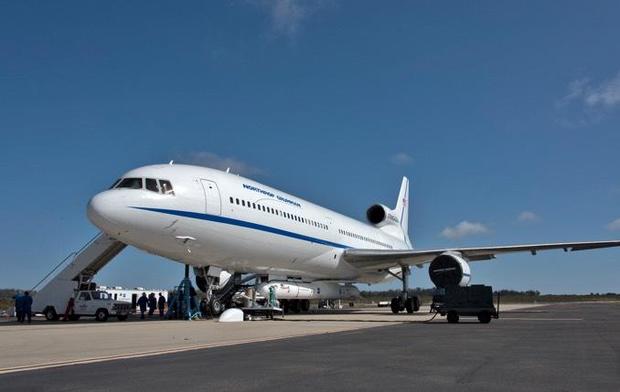NASA launches atmospheric research satellite — from an airplane
Running more than two years late, Northrop Grumman launched a winged Pegasus XL rocket from the belly of an L-1011 carrier jet Thursday to finally kick off a $252 million mission to study Earth's electrically charged ionosphere, its interactions with the solar wind and how it affects communications and GPS navigation signals.
The L-1011 "Stargazer" carrier jet, cruising at an altitude of 41,300 feet about 50 miles due east of Daytona Beach, Florida, released the 53,000-pound rocket at 10 p.m. EDT — 30 minutes later than originally planned because of a communications glitch between flight controllers and the carrier jet.
Five seconds after release, the 57-foot-long Pegasus XL's first-stage motor ignited with a rush of fiery exhaust to begin an 11-minute climb to orbit. A launch attempt Wednesday was scrubbed before the carrier jet took off because of expected storms along the flight path, but the weather cooperated Thursday and the Pegasus chalked up an uneventful climb to space.
"This one's been a long time in coming," said Omar Baez, the NASA launch director. "We had some setbacks early on in the middle of last year, and I'm glad we were able to get the payload up in orbit... Everything looks fantastic for us."
The goal of the Ionospheric Connection Explorer, or ICON, mission is to better understand the physics of the extreme upper atmosphere, how it responds to major space weather events like solar storms and flares and how it affects radio communications and satellite navigation signals that pass through it.
"The sun has a profound impact on our atmosphere, in fact it ionizes it, so it takes the molecules that are there and actually gives them a charge," said Nicky Fox, director of heliophysics research at NASA Headquarters. "We call that the ionosphere. It's very important for us to study this region."
"We use the ionosphere both to bounce radio signals off it ... and we also send our GPS signals through it. And so this ionosphere is continually changing, and it's very, very dynamic, and so that can have a big impact on our ability to do these type of communication."
The ionosphere begins about 37 miles up and extends to an altitude of some 620 miles. The 634-pound ICON satellite was designed to operate in a 360-mile-high orbit, about 100 miles above the International Space Station. Equipped with four sensitive instruments to characterize the electrically charged particles in the ionosphere, ICON is expected to operate for at least two years.
The spacecraft had an unusually rocky road to space. One of the booster stages was accidentally dropped during processing, prompting extensive inspections and analysis. Engineers then had to address concern about devices needed to separate the rocket's nose cone fairing during the climb to space. Launch slipped from late 2017 to June 2018.
Then, during a flight to ferry the Pegasus to its original Pacific Ocean launch site, engineers noticed unusual readings in the booster's rudder positioning electronics. The problem only showed up during flight, and it proved extremely difficult to resolve.
"This is an incredibly complex machine," said Phil Joyce, Northrop Grumman vice president of space launch programs. "We saw some things on our previous launch attempt that none of us were comfortable with. We decided to stand down and go address those and make sure we understood exactly what was happening there."
The detective work required "really extensive ground tests, modeling simulation and flight test activity to get to the bottom of what was an extremely challenging problem, one of the most challenging I've seen in my career in this business," Joyce said. "But we got there."
While no single root cause was identified, engineers modified the rudder positioning system electronics, replaced components in a positioning feedback system and carried out two L-1011 test flights to verify the system would work properly during launch. The work took nearly a year to complete.
"We wanted to get things right on this rocket," Baez said. "We have no second chances on these type of missions."






